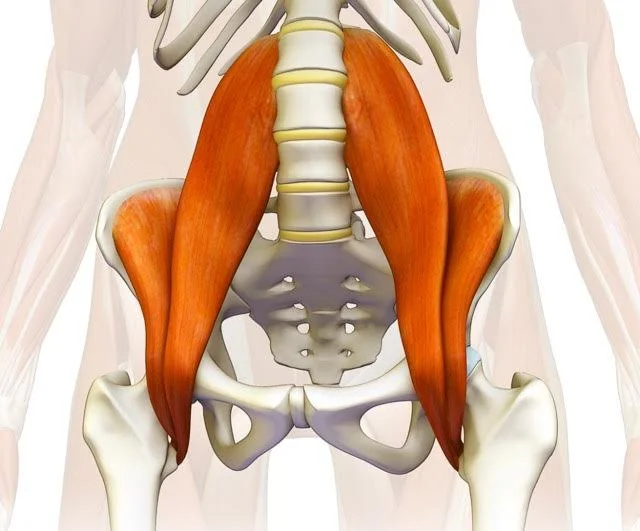The psoas muscle (part 1)
The psoas (full name iliopsoas) muscle is a pair of deep core muscles that is one of the few muscles in our body which connects our spine to our legs. It attaches on both sides of our spine, from the 12th thoracic vertebrae and all our lumbar vertebrae (and intervertebral discs), then wraps around the ball-and-socket joint of our hips and finally ends at our groin at the top of our femur (upper leg) bone.
It’s a big postural muscle that is responsible for so many of our movements. It is essential for correct standing or sitting posture, and it also plays a major role in stabilising our hip joint and determining our range of movement in the hip - which relates to how we walk and run.
The main reason a psoas muscle gets chronically tight (in other words, shortens) is due to prolonged sitting. (It can also get tight after experiencing trauma or sustained stress or a lengthy period coughing - we’ll go into why this is in a moment!) Whenever we sit down, the psoas muscle, which stretches from each side of our spine to each leg, contracts to allow the hip to bend. And the opposite applies too - when we’re standing or lying flat, the psoas needs to lengthen in order for our leg to straighten into this position.
The issue is, when we sit a lot over time, this muscle can become chronically tight. This means that when we go to stand, the psoas can no longer lengthen like it’s meant to and so it starts to ‘pull’ on our lower back when we try to stand up straight for instance - and then eventually whenever the muscle is engaged. As the psoas is our main hip flexor, it’s activated whenever we use our legs for movement - which let’s face it, is most of the time!
So a chronically tight psoas means we can start to experience restriction and pain or soreness which often occurs in the lower back, but may also be felt in the hips, glutes, pelvis or groin. You can almost guarantee if you’ve got a desk job or other seated job, there’s a high likelihood of having a chronically contracted psoas.
Iliopsoas Syndrome is just another way of referring to symptoms resulting from chronic tightness in the iliopsoas.
Signs you may have a tight psoas:
Pain or soreness in the lower or mid back, hips, glutes, pelvis or groin. This pain may be exacerbated by standing, sitting, walking, bending over or crossing legs (like when putting on shoes and tying shoelaces) as well as coughing or sneezing
Lumbar disc issues
Radiating pain down leg
Lower back spasms
Limping or discomfort standing on two feet without bending a knee for a prolonged period due to functional leg length discrepancy (which occurs when the psoas on one side is tighter than the other side). I call this ‘the flamingo’!
Shuffling or difficulty lifting leg, including to walk
Feeling of weakness in legs
Clicky hip (called Snapping Hip Syndrome) when the psoas flicks over the leg or pelvic bone making an audible sound
Hyperlordosis (excessive curvature of lumbar spine)
Anterior pelvic tilt.
OK, so what has trauma, stress and coughing got to do with a tight psoas? It’s because the psoas and the diaphragm, which is the muscle responsible for our breathing, are joined by the same connective tissue. This connective tissue (called fascia) is what Bowen therapists mainly work with and how they view the body, to see how things are connected and how pain can refer elsewhere along the body/fascial line depending on what is being affected.
Because the psoas and diaphragm muscles are connected, coughing or sneezing can impact the psoas and vice versa. It’s a very big clue to me that the psoas needs to be addressed in a Bowen therapy treatment if someone says that they have lower back pain which is exacerbated every time they sneeze or cough. Likewise, when I have a new client who speaks about trauma/grief/stress, I will always check their psoas for tension as it’s very often extremely tight. This is because when a person has been under stress or locked in ‘fight or flight’ mode, their breathing becomes shallow, which in turn impacts the psoas. There is so much to say on the connection between the psoas and our emotional state so I will save that for another post.
What can you do about a tight psoas? As a first step, if you’re in Sydney - come and see me for an assessment and Bowen therapy treatment to help release the psoas! In my next post I’ll pop up some tips and tricks for what you can do at home to help address a tight (and/or weak) psoas.
It’s such an amazing muscle because it has a massive impact not just on our physical health but mental and emotional too. Unfortunately it seems to be often overlooked as a source of people’s pain so I plan to dedicate the next few blog posts on sharing different aspects of the psoas in a bid to help get the word out about it.
If you have any questions about the psoas, please feel free to get in touch - my contact details can be found here. Or if you’re from Sydney and you’re ready to roll with a Bowen therapy treatment, please note that appointments can be booked online via my Spring Bowen Therapy website.

